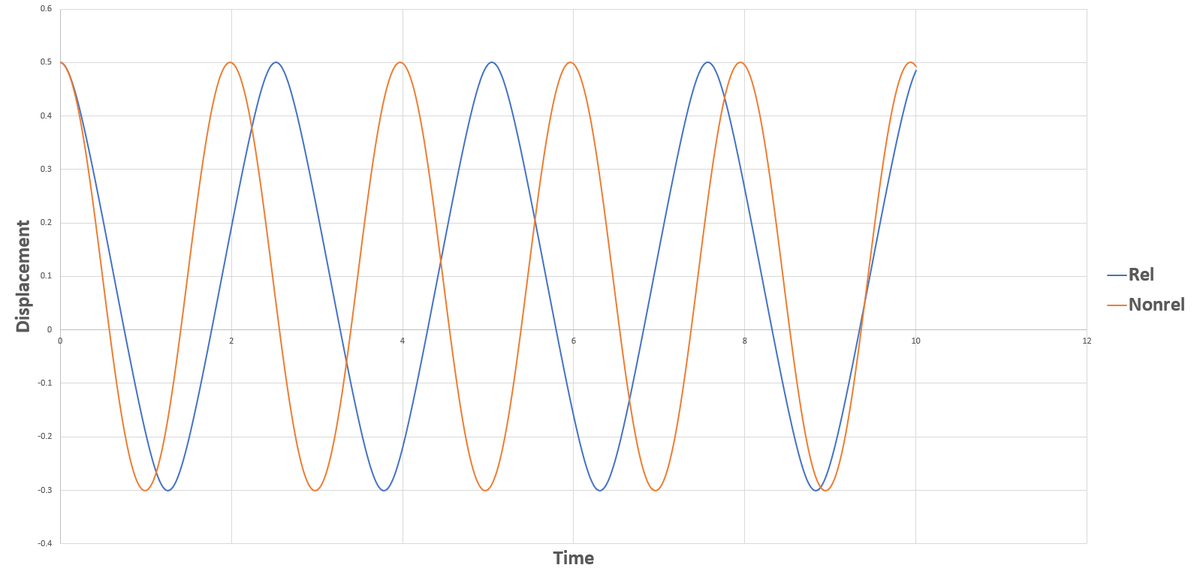Hypothetical Relativistic Oscillator
Consider a relativistic point object of rest mass m = 1 attached to a spring of stiffness k = 1 0 and natural length L o = 0 . 1 . The other end of the spring is attached to the origin. The mass is initially displaced by 0.5 units along the positive X-axis and is then released from rest. Enter your answer as the time period of the resulting oscillations.
Bonus: Perform a non-relativistic treatment of this scenario and compare the results. Under what circumstances will the relativistic prediction agree with the classical one?
Note:
-
The spring's behaviour is governed by Hooke's law
-
For a relativistic particle of rest mass m moving with velocity V , its linear momentum is defined as:
p = c 2 − ∣ V ∣ 2 m c V
- Speed of light - c = 1
The answer is 2.522.
This section requires Javascript.
You are seeing this because something didn't load right. We suggest you, (a) try
refreshing the page, (b) enabling javascript if it is disabled on your browser and,
finally, (c)
loading the
non-javascript version of this page
. We're sorry about the hassle.
3 solutions
The Lagrangian is:
L = − m c 2 1 − c 2 x ˙ 2 − 2 1 k ( x − L 0 ) 2
Plugging in numbers:
L = − 1 − x ˙ 2 − 5 ( x − 0 . 1 ) 2
Equation of motion:
d t d ∂ x ˙ ∂ L = ∂ x ∂ L
Evaluating results in:
x ¨ = x ˙ 2 ( 1 − x ˙ 2 ) − 3 / 2 + ( 1 − x ˙ 2 ) − 1 / 2 − 1 0 ( x − 0 . 1 )
Note that at low speeds ( x ˙ 2 < < 1 ) , this expression reduces to just the numerator, which happens to be the classical Newton's 2nd Law. The period of a mass-spring oscillator is proportional to the square root of the mass, and relativistic particles behave as if they have more mass than classical particles. So we expect the period for the relativistic oscillator to be greater than that of the classical oscillator. The graph below demonstrates that behavior. Simulation code is also attached.

1 2 3 4 5 6 7 8 9 10 11 12 13 14 15 16 17 18 19 20 21 22 23 24 25 26 27 28 29 30 31 32 33 34 35 36 37 38 39 40 41 42 43 44 45 46 |
|
Thanks for the solution. Doing a pendulum variant of this would require that I look further into the formulation of gravity. Analysing relativistic motion from a non-moving frame of reference does give several insights about particle motion at very high speeds. But I cannot think of more challenging variants at the moment as solving such problems has a pretty standard recipe.
I will try and understand some of the concepts (time dilation, etc.) following which I will think of a problem or more where motion is analysed from moving frames of reference.
Log in to reply
I may have spoken too soon. Another one coming up..
Solving the equation of motion of the particle we get the following expression for the magnitude of velocity :
v = d t d x = 2 m c 1 4 m c 2 k ( x 0 2 − x 2 ) − k 2 ( x 0 2 − x 2 ) 2 = 2 1 0 ( 0 . 2 5 − x 2 ) − 2 5 ( 0 . 2 5 − x 2 ) 2 .
Integrating this from x = 0 to x = x 0 , we get one fourth of the time period as 4 T ≈ 0 . 6 3 1 . Hence the required time period is ≈ 4 × 0 . 6 3 1 = 2 . 5 2 4 .
Rather than the solutions shown below, I will proceed with a Newtonian solution.
The force acting on the particle is given by the change in momentum:
F = d t d p
When special relativity is factored in, time is dilated and the time observed in an outer reference frame (our reference frame) to compensate for the high velocity increasing towards the speed of light.
The linear momentum of the relativistic object in this case is:
p = 1 − x ˙ 2 x ˙
Taking the derivative with respect to time of the momentum, we have:
d t d p = ( 1 − x ˙ 2 ) 2 3 1 x ¨
So the equation of motion of the particle becomes:
( 1 − x ˙ 2 ) 2 3 1 x ¨ = − k x
We can numerically solve the second order ODE above using the Runge-Kutta 4th Order. Code is shown below. Here are the graphs showing the speed of the particle according to the Classical and Relativistic model. One is right and the other isn't; the speed of light is exceeded in one: